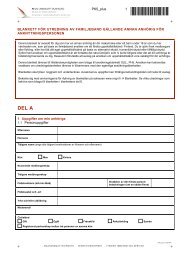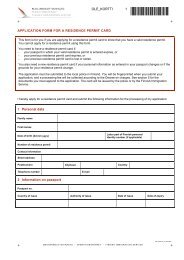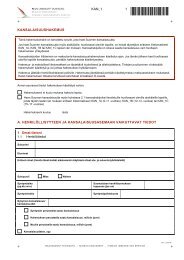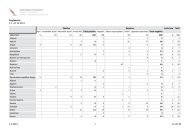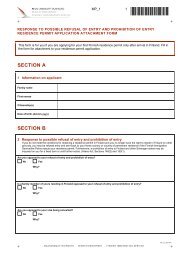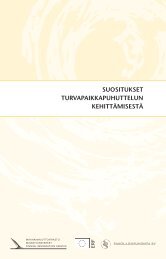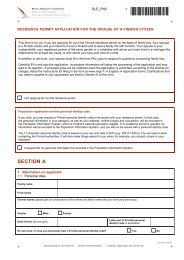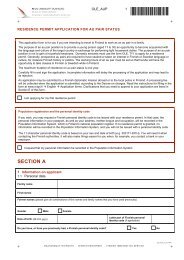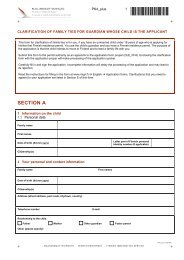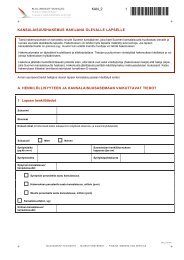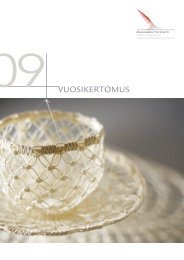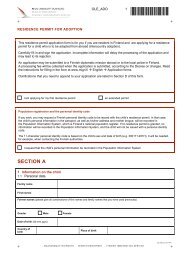Afghanistan Fact-Finding Mission 2009
Afghanistan Fact-Finding Mission 2009
Afghanistan Fact-Finding Mission 2009
- No tags were found...
Create successful ePaper yourself
Turn your PDF publications into a flip-book with our unique Google optimized e-Paper software.
3/024/<strong>2009</strong>TRIP REPORT11 February 2010 European Return FundFACT-FINDING MISSION TO AFGHANISTAN BY THE FINNISH IMMIGRATION SERVICEEuropean Return Fund<strong>Fact</strong>-finding missionOne of the aims of the project for the development of a country of origin informationsystem on <strong>Afghanistan</strong> for ensuring conditions for safe return was to arrange a factfindingmission to <strong>Afghanistan</strong>. The purpose of this report is to distribute informationabout the mission not just to Finnish authorities, but also to the immigrationauthorities of the EURASIL and IGC member countries.The security situation in <strong>Afghanistan</strong> fluctuates greatly, both periodically andregionally. The purpose of the project is to create for the use of the FinnishImmigration Service and the Police, who enforce decisions to remove aliens fromFinland, a country of origin information system for the assessment of the securitysituation in <strong>Afghanistan</strong>. Such a system would make it possible to make anunfailingly reliable and up-to-date assessment of the conditions for safe return bothat the decision-making stage and at the removal stage. Information would also beprovided for authorities who organise the voluntary return of citizens of <strong>Afghanistan</strong>.On 7 April <strong>2009</strong>, the International Affairs Unit of the Ministry of the Interior made adecision to provide funding from the European Return Fund and to confirm nationalfunding for the project. On 4 March <strong>2009</strong>, the executive group of the EuropeanReturn Fund proposed that the project should be financed from the fund’s annualprogramme for 2008.The Finnish Immigration Service made the trip together with the Immigration Policefrom September 24 to October 2, <strong>2009</strong>. In planning the composition of the travellingparty, the distribution of enforcement and execution duties related to removaldecisions between the Police and the Finnish Immigration Service was taken intoconsideration. Removal decisions are taken by the Finnish Immigration Service andenforced by the Police. An official from the Asylum Unit was among the participantsso that essential information to support decisions on international protection wouldbe obtained from the mission. The task of the Legal Service and Country InformationUnit is to serve as Finnish Immigration Service experts in country information andlegal affairs. A senior adviser of legal services and a country information researcherfrom the unit were among the mission participants. The police chief inspector whowas on the trip focused on practical measures such as the future procedures to befollowed in returning Afghan citizens removed from Finland to <strong>Afghanistan</strong>, localauthorities’ requirements related to issues such as identity papers and advancenotifications, and the procedures followed by the other Nordic countries, taking intoaccount the existence of repatriation agreements.One part of the fact-finding mission was to extend the country of origin informationsystem beyond Kabul. Most of the asylum-seekers in Finland come from a remote
3 (18)The compilation of statistics on crime is developing in <strong>Afghanistan</strong>. There aresituation centres in operation in Kabul and in a number of provinces. Because of theprevalence of tribal communities, there is little actual everyday crime. There aremany reports, however, of honour killings and the disappearance of women.Families have also been threatened in some more remote provinces.Meetings with two returneesEUSRAAccording to the original plan, the country of origin information system wassupposed to be extended, besides Kabul, to the nearby Ghazni province. For thatreason, we made arrangements prior to the start of the mission to meet a Jaghoricouple in Kabul. The goal was to obtain information from them on Ghazni andspecifically Jaghori.The interviewee (male) had worked with Future Generations 6 assistance projectsand is now assisting American ISAF-PRT construction projects in Ghazni throughhis own company P.C.C 7 . He had just returned from Ghazni before the interview andshowed us photographs of Jaghori, his place of domicile. According to him, it isdangerous to drive by car from Ghazni because of possible Taliban checkpoints. Hehas built 8 schools for girls at Jaghori and organised adult education with instructionfor women in fields such as midwifery, computer and sewing machine use,embroidery, the preparation of jams and jewellery making. A computer class hadbeen provided for Jaghori residents and young men were persuaded to substituteOriental martial arts and other sports for drugs 9 .Electricity can be produced for the area by damming the Jaghori reservoir and bymeans of hydroelectric power. Agriculture has been made more effective,groundwater has been raised closer to actual ground level, seedlings have beenplanted and greenhouses have been built. At present, his projects include theimprovement of vocational training and the lengthening of the runway of an airfieldthat he has had built.The human rights advisor of the Special Representative of the European Union 10cooperates with civic organisations and investigates cases of violence againstwomen and threats against the media. He told us about a repatriation study whichindicated that persons who returned voluntarily found it more difficult to adapt totheir return than other returnees. It was thought that the reason for this was that theyhad greater expectations related to their return than involuntary returnees.In <strong>Afghanistan</strong> as many as 70% of men and 90% of women are illiterate. The factthat over 60% of Afghans are under 25 years of age is a good indication of the ageclassdistribution. The education of young people is important because the future ofthe country depends on them. However, hundreds of schools have been forced to6http://www.future.org/international-operations/afghanistan (visited on 23 November <strong>2009</strong>)7Pulgoo Construction & Supply Company8On assignment from Future Generations.9During the interview, he showed photographs of Jaghori residents in a computer class and in a textile class, as well as involved insports activities.10Human Rights and Rule of Law Advisor, Office of the Special Representative of the European Union for <strong>Afghanistan</strong>.
4 (18)close because of their remote location or because of Taliban threats. Fighting hasincreased in <strong>Afghanistan</strong> and the number of civilian victims has risen. Therepresentative emphasised the responsibility of the international community inmonitoring projects and urged us to be cautious and discerning in our informationgathering.AREUAREU 11 is an independent research organisation founded in Kabul. The assistantdirector whom we interviewed has lived in Kabul for six years. The task of AREU isto gather and distribute information. It aims at improving the life of the Afghansthrough its activities.AREU has an annual publication entitled “The A to Z Guide to <strong>Afghanistan</strong>Assistance”. It also issues a mimeographed bibliographic publication called the<strong>Afghanistan</strong> Research Newsletter every two or three months as well as manydifferent studies. All of its printed materials can also be found in electronic format onthe Internet. Research projects have been completed in 150 different fields of life.AREU has a public library. The catalogue of its collections is available on theInternet. 12AREU is compiling a list of laws in force. According to the assistant director,information about new laws is hard to come by because only the powers that behave effective legislation in their possession. We received a list prepared in 2005. Ithas been continued for laws that have been translated into English.According to the representative, the problem facing the government of <strong>Afghanistan</strong>is that it either lacks information or that it has no system for distributing information.For example, demographic statistics are politically sensitive, so that no census hasbeen undertaken since 1979, and even then it was incomplete. Requests forinformation on the number of women were partly made to men only. All publicpopulation numbers are merely estimates.According to the representative, the news agency BBC Monitoring is a good sourceof information. True to its name, the news agency Pajhwok 13 is a Pashto-languagesource, and more expensive than BBC Monitoring. The radio is an important andreliable source of information in <strong>Afghanistan</strong>, and an even more important mediumthan the press. Local police and security guards frequently listen to the radio to findout about the security situation. A list of local media is available on the Internet. 14UNAMAThe task of UNAMA 15 is to promote peace and balance and to direct the efforts ofthe international community in <strong>Afghanistan</strong>. UNAMA has operations in some 20Afghan provinces, which have been divided into eight major regions with UNAMA11<strong>Afghanistan</strong> Research and Evaluation Unit, http://www.areu.org.af/ (visited on 25 November <strong>2009</strong>)12http://nzdl.sadl.uleth.ca/cgi-bin/library.cgi?a=p&p=about&c=areu&l=en&nl=1 (visited on 20 November <strong>2009</strong>)13Pajhwok Afghan News, http://www.pajhwok.com (visited on 18 January 2010)14http://www.abyznewslinks.com/afgha.htm. (visited on 25 November <strong>2009</strong>)15United Nations Assistance <strong>Mission</strong> in <strong>Afghanistan</strong>, http://unama.unmissions.org (visited on 20 November <strong>2009</strong>)
5 (18)regional offices. UNDSS 16 , which is the UN security department, operateseverywhere where the UN operates and ensures the safety of the staff of the worldorganisation. UNDSS prepares daily, weekly and monthly reports for its internal use.Statistics have been kept since 2003 or 2004. To a limited extent, they can be askedto provide statistical information, such as information covering a certain area orperiod. UNAMA’s sources of information include the Afghan police (ANP) andsecurity service (NDS), foreign soldiers (ISAF) and civic organisations. It exchangesinformation with ANSO.UNHCR 17Spatial and temporal variation in <strong>Afghanistan</strong> is extensive. The security updates andthe eligibility guidelines for international protection of asylum-seekers of the UN HighCommissioner for Refugees 18 have served to support national decision-making inthe assessment of international protection needs of asylum-seekers. Partly for thelack of resources and because UNHCR no longer has access to all the provinces, ithas become impossible to keep an up-to-date list of security updates. UNHCR hasbeen forced to reduce its operations by approximately two per cent and itrecommends the use of other information sources in lieu of its security updates. Asan example of available sources, the representative mentioned the bibliography inthe eligibility guidelines 19 issued in <strong>2009</strong>. He also believed that it was important tosearch for various and recent province-specific sources for common use.Some 200,000 to 300,000 people return to <strong>Afghanistan</strong> annually. In <strong>2009</strong>, some53,000 Afghans returned from Pakistan. In 2008, 200,000 Afghans returned fromPakistan and 460,000 from Iran. Despite continuing fighting, the number ofreturnees is evening out. As a rule, returnees settle in cities. 20 Surprisingly, theevents in Swat valley had no long-term effect on the migration pressures in theregion.In Iran, the standard of living is better than in Pakistan and <strong>Afghanistan</strong>. Themajority of the returnees are young men, some of whom have lost their traveldocuments. There is discrimination against foreigners in Iran and areas with noaccess to foreigners have been established there 21 . Foreigners have been removedby force from border regions. UNHCR monitors the humanitarian situation ofreturnees.The usefulness of tripartite agreements is being re-assessed. UNHCR is hopefulthat Iran will sign such an agreement with <strong>Afghanistan</strong> and renew the existingagreement with Pakistan.IOM16The United Nations Department of Safety and Security, https://dss.un.org/dssweb/ (visited on 25 November <strong>2009</strong>)17United Nations High Commissioner for Refugees, http://www.unhcr.org/cgi-bin/texis/vtx/home (visited 25 November <strong>2009</strong>)18http://www.unhcr.org/refworld/country,,,COUNTRYPOS,AFG,4562d8cf2,48ea34872,0.html (visited on 29 December <strong>2009</strong>)19http://www.unhcr.org/cgi-bin/texis/vtx/refworld/rwmain?docid=4a6477ef2&page=search (visited on 23 November <strong>2009</strong>)20Returnees include Pashto speakers.22These “no-go areas for foreigners” are located near borders.
6 (18)IOM 22 representatives told us about voluntary repatriation and humanitarianassistance. IOM provides accommodation and starter money for returnees. They aregiven about two weeks’ time to look for their relatives, after which arrangements aremade for transport home. Arrangements are started even before repatriation. IOMrepresentatives assist returnees as early as passport control at the airport, but theydo not provide assistance in the case of involuntary returns. The criterion forvolunteering is the fact that the person has received financial assistance for his orher repatriation.Just as with UNHCR, IOM receives its security information from UNDSS. Theinformation relates to staff security but also has an effect on the assessment of thesecurity of escorted Afghans. The daily situation fluctuates and IOM does not take astand on where anybody can be returned safely.IOM has tentative plans for new procedures related to repatriation. These will notcause changes to voluntary repatriation. In repatriation matters, embassies shouldtake an active stand towards Afghan authorities, especially towards the Ministry ofRefugees and Repatriation.AIHRC<strong>Afghanistan</strong>’s independent human rights commission AIHRC 23 is an importantreporter on human rights. Its reports have started to attract attention and, for thatreason, its influence has increased. It publishes annual reports on human rightsoffences 24 . AIHRC activities cover a large part of the country. Previously, AIHRCrepresentatives had easier access than government or foreign representatives tomany places. About seven months prior to the interview, village elders started toissue exit orders for fear of the Taliban. Because of the weakened security situation,AIHRC has been forced to curtail its field activities by approximately 10% in 2007,about 9% in 2008, and as much as 30% in <strong>2009</strong>.International Committee of the Red Cross 25 (ICRC)The Red Cross has been helping the victims of conflicts in <strong>Afghanistan</strong> for as longas 30 years without interruption. Firstly, it provides protection in prisons andsecondly, it provides services for the purpose of family reunification (bypost/telephone and for children by physically taking them to their parents) andthirdly, it assists civilian victims of military operations.During our visit, we were told how the Red Cross has arranged for the supply offood, medicine and accommodation as well as polio vaccinations, provision ofprostheses, water supplies and sewerage in <strong>Afghanistan</strong>. The Red Cross has twohospitals (in Sheberghan and Kandahar). First aid is also provided in trouble spots,where agreements have been made on ambulance transports for the wounded andthe gathering of bodies. Aid is provided for farmers to support the supply of food,and lectures on international justice are arranged for the army. The victims of naturaldisasters are taken care of primarily by the Afghan Red Crescent Society (ARCS).22International Organization for Migration – <strong>Afghanistan</strong>, http://www.iom.int/jahia/Jahia/pid/490 (visited on 18 January 2010)23<strong>Afghanistan</strong> Independent Human Rights Commission, http://www.aihrc.org.af/ (visited on 18 January 2010)24For the 2008 report, see http://www.aihrc.org.af/Rep_Annual_2008.pdf (visited on 18 January 2010)25International Committee of the Red Cross, http://www.icrc.org/ (visited on 18 January 2010)
7 (18)The information gathered by the International Red Cross is confidential. UNDSS andANSO collect conflict statistics, which correspond fairly well to the conceptions ofthe Red Cross. The Red Cross moves around the regions without weapons orarmoured vehicles. It is the only international organisation also to maintain contactswith the Taliban. There was a setback in 2003 when a Taliban fighter, who at onetime had been cared for by the Red Cross, knowingly and with full intent murdered arepresentative of the organisation. After that, the Red Cross has not been movingoutside the cities. In 2006, a new dialogical connection secured renewed access toTaliban-controlled areas.The International Red Cross provides opportunities for assisted searches forinformation about family members. Because the International Red Cross providesprotection in prisons, asylum-seekers can obtain information about theirimprisonment to support their applications for asylum. 26 The International Red Crossdoes not store information on all imprisoned persons, and the lack of informationdoes not necessarily mean that the applicant was not imprisoned. Information is onlygathered on certain persons and only if a delegation has visited the prison inquestion. Contact, i.e. request for information, is always made through a nationalRed Cross organisation.Ministry of Refugees and Repatriation 27The Minister of Refugees and Repatriation is responsible for Afghans living abroad,returnees and intra-country refugees. Since 2001, some 5 million refugees havereturned to <strong>Afghanistan</strong>, and some 4 million Afghans still live as refugees in foreigncountries.Multiple nationality is allowed because brothers must be equal before Afghanauthorities, even if some of them had citizenship in another country. A returnee isthus interpreted as being an Afghan citizen. In the opinion of the Minister ofRefugees and Repatriation, there is no need for legislative changes, though Karzaipromised some kind of constitutional change in his election campaign.<strong>Afghanistan</strong> follows the principle of blood descent, 28 which means that a child bornabroad automatically acquires Afghan citizenship if both parents are Afghan citizens.The citizenship law has been updated with every constitution.<strong>Afghanistan</strong>’s Central Statistics Organization maintains a population register ofcitizens. People who have received a national identity card are entered in theregister. Only a fraction of the population belongs to that group.The Criminal Technic Department of the Ministry of the Interior verifies the technicalauthenticity of an identity card. The authority that has issued the document verifiesits origin. If a person has a birth certificate issued by a hospital, the Ministry of PublicHealth verifies its authenticity. The Ministry of Education and the Ministry of HigherEducation verify the authenticity of school certificates. However, it can happen thatan adult Afghan who has been living in the countryside has no proof of identitywhatsoever.26ICRC27Ministry of Refugees and Repatriation28Cf. the principle of blood descent (jus sanguinis) and the principle of place of birth (jus soli)
8 (18)The Embassy of NorwayAbroad, Afghan embassies can issue passports to Afghan citizens. The embassiesdo not provide any other documentary proof of identity. Their task is to verify thecitizenship of passport applicants. If a person has no proof that he or she is Afghan,their identity must be established using information such as the person’sprovince/town/village of birth and father’s name. The applicant’s citizenship is alsoverified by questions related to father’s name and local information on home village(familiarity with its schools, clinics, etc.). The same procedure is used for persons tobe returned to <strong>Afghanistan</strong>.There have been cases in which a person has been returned to <strong>Afghanistan</strong> andhas then been found to be a Pakistani or an Iranian. In such cases, the person hasbeen sent back to the country of departure with escort. A country that sendsreturnees to <strong>Afghanistan</strong> should verify their citizenship with the Embassy of<strong>Afghanistan</strong>. If a returnee is a criminal, an advance notification should be made tothat effect. Afghan delegations also travel to foreign countries to check whetherpersons are Afghan citizens. The checking is done by questioning the personinvolved. The minister mentioned a delegation that was about to leave for France onthe same day.The following conditions for repatriation were announced by the minister:• The person to be returned must not be a person who has been granted thestatus of refugee.• The person must not come from so-called dangerous areas.• Criminals and persons who have not been granted a residence permit in thecountry which wants to return them (e.g., refusal of entry) can be returned.• Before repatriation, the ministry should be informed of the decision and allappellate levels should have been used.According to the minister, IOM provides repatriation assistance. This applies mainlyto countries with an effective repatriation agreement.The minister expressed a desire for a repatriation agreement signed by Finland,<strong>Afghanistan</strong> and UNHCR. In this way, repatriations could be organised flexibly andefficiently while taking into consideration returnees’ own premises and needs.Norway started repatriations in 2006 and repatriated 52 Afghans in 2008. In 2008,13 Afghans returned voluntarily, and in <strong>2009</strong>, 16 Afghans returned during just twomonths, which may have been caused by changes in the policy related to aliens. Atotal of 104 Afghans have returned from Norway to <strong>Afghanistan</strong>. 29Norway’s three-year repatriation agreement expired on 10 August <strong>2009</strong>, but it wasextended to 31 December <strong>2009</strong>. The greatest worry is about minors, who comprise40% of all Afghan asylum-seekers (in 2008, they numbered 1,300). The intention isto make changes to the agreement in this respect so that families with children can29Cf. the Eurasil survey “Eurasil Workshop on <strong>Afghanistan</strong> 10.12.<strong>2009</strong>” submitted by Norway. According to the survey, 133 personswere repatriated from Norway in 2007, 52 persons in 2008, and 31 persons in <strong>2009</strong> by November. Voluntary repatriations numbered31 in 2007, 13 in 2008 and 31 in <strong>2009</strong> by October.
9 (18)The Embassy of Swedenalso be repatriated. So far no children or single women have been repatriated,though one couple has been returned. Norway has investigated through IOM whatkind of housing, schools and providers are needed in order to repatriate children.The Afghan Ministry of Education takes a positive view of some projects, but it isimportant that the Afghan Ministry of Foreign Affairs and the Ministry of Refugeesand Repatriation are responsive towards the matter.At present, Norway repatriates two Afghans per week on average. Norwegian policeofficers return from their escort trips on the same planes via Dubai and sometimesby Safi 30 via Frankfurt. The police only announce their arrival six to seven days inadvance because they cannot keep returnees in custody longer than two days.Sometimes returnees may get hold of the advance information on the repatriation,which will thus prevent them from being caught and repatriated.IOM makes arrangements for voluntary repatriations, but involuntary returns are theresponsibility of the police and IOM admits them into its integration programme onlyafter passport control. Previously, Norway also sent an advance notification toUNHCR, but presently the notification is sent to the Ministry of Refugees andRepatriation only.Sweden’s Tripartite Memorandum of Understanding expired in July. The Minister ofRefugees and Repatriation had hoped for changes to it, yet finally agreed to extendit without changes until the end of April. Nevertheless, the Afghan Ministry ofForeign Affairs demanded changes, and so negotiations must soon be continued. Atpresent, Sweden only repatriates criminals and voluntary returnees.In order to help voluntary returnees, IOM first required an agreement betweenSweden and the Afghan Ministry of Refugees and Repatriation. Until 1 May <strong>2009</strong>,UNHCR gave notice as to who were escorted to <strong>Afghanistan</strong>, but now Sweden itselfgives notice directly: the police or the Migration Board provides the names for theembassy two weeks in advance and the embassy gives the airport and the Ministryof Refugees and Repatriation oral notice and ten days to respond. However, they donot usually respond to the notice and the repatriations go well.In 2008, 25 Afghans returned voluntarily and 28 Afghans involuntarily. From Januaryto April <strong>2009</strong>, the corresponding figures were 12 and 17. The figures included lonechildren, whose number increased by 144% in Sweden last year. In <strong>2009</strong> (by theend of May), Sweden received 222 Afghan asylum-seekers, 80% of whom weregranted asylum (last year 347). However, the figure includes a large number ofIranians. The Swedish fact-finding mission was postponed, 31 while the Norwegianspaid a visit about two weeks earlier.The embassy suggested that a good source of information would be the Mazar-i-Sharif-based Swedish Committee for <strong>Afghanistan</strong> 32 – a development cooperationorganisation funded by Sweden. Its representative arrived for the first time in30http://www.safiairways.aero/ (visited on 8 January 2010)31The Swedish fact-finding mission was undertaken in December <strong>2009</strong>.32http://www.swedishcommittee.org (visited on 20 November <strong>2009</strong>)
10 (18)<strong>Afghanistan</strong> as early as 1981. The organisation has an office in Kabul and employsthousands of Afghans.The Embassy of DenmarkSECURITYThe Danish embassy mainly acts as a means of communication between Danishand Afghan authorities. Ten percent of one official’s work contribution is devoted toaliens’ affairs, though visa-related matters are dealt with in Islamabad. Few EUcountries issue visas in Kabul. The embassy consults the police about asylumseekersbut does not carry out investigations of its own. Instead, it forwards queriesrelated to matters such as the authenticity of passports through IOM to the AfghanMinistry of the Interior, which verifies their authenticity with the passport holder’shome municipality. The embassy sends notification of the return of rejected asylumseekersto UNHCR, IOM, the Ministry of Refugees and Repatriation, the Ministry ofthe Interior, and the airport, where IOM, the embassy, and usually UNHCR receivethe returnees and monitor the activities of Afghan authorities.Denmark has signed an agreement with IOM on a support package, which includesguidance, medical services, contacts with relatives and starter money. The moneycan be used to buy a flat or tools to support an Afghan’s private enterprise activities.Denmark is the only country with which IOM has cooperated in receiving involuntaryreturnees. The agreements have been extended to the end of the year and theyhave worked well as such. They will be replaced by a new agreement.Law-enforcement authorities<strong>Afghanistan</strong> has a police force of some 92,000 members. 33 . The training of civiliansas police was started by the Germans in 2006 and it has progressed well. Themajority of police are ethnically Pathans, though there are also other nationalities.No nationality-based problems exist among the police. 34The Americans arrange a basic eight-week training for the police and the EUprovides further training for nine months. The graduates of a three-year police officertraining programme receive the rank of lieutenant colonel and can also be postedoutside their home area. The basic pay of an ordinary member of the police force is80-150 dollars per month. The Americans aim their training at the creation of aparamilitary force, whereas the EU countries prefer a more European-style policeforce. 35There are 800 policewomen in <strong>Afghanistan</strong>, and the Ministry of the Interior intendsto raise their number to 5,000. They are mostly stationed in major cities becausethey are subjected to threats in rural areas and three of them have lost their liveswhile on duty. The training, duties and pay of policewomen do not differ from thoseof policemen but they operate as a separate branch. 3633EUPOL. The Ministry of the Interior for Security told us that there were 96,000 policemen and 800 policewomen. This figure includesone female general, which is still too few.34EUPOL35EUPOL36Ministry of the Interior for Security
11 (18)There are no reports of anyone having been persecuted because of their servicewith the police. However, some of their relatives are known to have been subjectedto threats in remote areas. If a member of the police force refuses to perform his orher duties, the police legislation provides sanctions for it, sometimes more lenientthan imprisonment. It is possible to resign from the police force. The UN has goodrelations with the local police, trained by EUPOL and its American counterpartCSTC-Alpha (Combined Security Transition Command – <strong>Afghanistan</strong>). Kabulappoints the leaders of the police force. 37 Customs is under the Ministry of Finance.The Customs police are under the Ministry of the Interior, however, as are the rest ofthe police force. 38<strong>Afghanistan</strong> also has a security service called the National Directorate of Security(NDS). The exact number of the members of the <strong>Afghanistan</strong> security service isunknown, but it may be as high as 100,000, while the actual payroll is 20,000-30,000. 39 The security service does not assist private persons, but the counterterrorismsection of the Ministry of the Interior once tracked down a person who hadmade threatening phone calls. The person in question was successfully arrestedand sentenced, but it was not found out who his principal was. The person wasacquitted on appeal 40The activities of the Taliban and other groups in <strong>Afghanistan</strong>Security is a multifaceted issue and it is also threatened by groups other than theTaliban. 41 . The Taliban set up their roadblocks 42 mostly at night and for a shortperiod of time, from half an hour to two hours. There are no statistics on roadblocksand the police are primarily notified of cases that have caused problems. OrdinaryAfghans who do not work for the government or international organisations,however, may usually move around fairly safely.The Taliban leader, Mulla Zakir, replaced Bahadir in late summer <strong>2009</strong>. Six monthsago, the Taliban prepared its Code of Conduct, which became public four monthsago. The Taliban leadership council 43 , which was established in the city of Queta,Pakistan, issues orders to district commanders, who do not tolerate independentactivities at the local level. However, various local and district-level Taliban groupsare sometimes at odds about booties when, for example, a leader wants one fourthof the booty. 44The Taliban has also announced that it will no longer attack foreign civilians andlocal inhabitants who are not in the employ of foreign soldiers or the government.Activities such as interpreting for soldiers, for example, are dangerous. The locallevel of the Taliban is dispersed as the Americans have been killing its leaders.Secret negotiations have been conducted with the Taliban for as long as 1.5 years37EUPOL38Kabul International Airport, Ministry of Transport and Civil Aviation39Tundra/JICA40AIHRC41The Embassy of Denmark42Because of possible roadblocks, we could not undertake a road trip to Ghazni.43Taliban leadership council or Shura (Afg.)44Tundra
12 (18)with the aim of persuading it to undertake peaceful political action. The Taliban in<strong>Afghanistan</strong> is not as global as the Taliban in Pakistan and the Afghans do notrender services to al-Qaida. 45During last year, the Taliban’s troops were observed to include members other thanPashto-speakers (Pathans), that is, Tadzhiks and Uzbeks (Islamic Movement ofUzbekistan [IMU], active in Kunduz). They are not press-ganged; instead, they arevolunteers who either expect the Taliban to win or are frustrated with the presentsituation. Hazaras continue to be the most unlikely to submit to the attraction of theTaliban. People say that the fear of the Taliban is reflected in the demand forKalashnikovs and burqas, which is apparent in their price. 46ProvincesAccording to UNAMA, the safest provinces are Khost, Paktia, Nangarhar, Wardak,Logar, and all of the northern provinces, that is, Balkh, Jowzjan, Faryab, Sar-i-Pol,Samangan, Parwan, Kapisa, Panjshir, Badghis and Herat. UNAMA has regionaloffices in Kunduz, Baghlan and Badakhshan, which were peaceful for a long time,though now incidents are also starting to crop up there. The area surrounding thecapital of Badakhshan is difficult for travelling due to a poor road network. An officewill be established in Takhar. Paktika, Laghman and Nuristan have no office. Theaim is to open an office in Ghazni this year because the area is safe, though theroad leading there is not safe. 47According to information received from the Danish embassy, parts of Helmand andKandahar are generally insecure. Kabul and Jalalabad are safe for Afghans. 48According to UNDSS, too little security information is available from Helmand (whichis inaccessible), Kandahar (one half of the municipalities), Nimroz (with theexception of Zaranj), Uruzgan (with the exception of Tarin Kowt), Zabul (with theexception of Qalat), Kunar (with the exception of Asadabad – the rest of theprovince is in a state of war), Ghor (with the exception of Chaghcharan).Sometimes, access to information is hampered less by unrest than by the weatherand poor communications. 49According to a representative of the Red Cross, travel in Kandahar is very limitedand Herat was opened only recently. The situation in northern <strong>Afghanistan</strong> is stillunder control, though weakened. The Bamiyan area is safe. The Red Cross list ofthe places where it operates gives an idea of safe areas. For example, the RedCross does not operate in the Khost, Paktia, Paktika and Logar provinces, or thePech Valley in Kunar province. The situation in northern <strong>Afghanistan</strong> is still undercontrol, though weakened. Ghazni itself is not a problem, but the road leading thereis difficult. The Bamiyan area is safe. 5045Tundra46Tundra47UNDSS/ UNAMA48The Embassy of Denmark49UNDSS/ UNAMA50ICRC
13 (18)Opium productionKidnappingsLand disputesAIHRC has been forced to pull out from Paktika, Khost, Helmand, Kandahar,Ghazni, Uruzgan, Farah, Faryab, Baghlan and Kunduz provinces, and even fromJowzjan. 51 Travel in Kandahar is very limited and Herat has been opened onlyrecently 52 .The production of opium has decreased in <strong>Afghanistan</strong>, but there are considerableamounts of opium in storage and it is exchanged for weapons north of Kunduz at theTadzhikistan border. Human smuggling through Iran or Pakistan is also a significantbusiness activity. 53Kidnappings are a common occurrence. During the night between 25 and 26September, <strong>2009</strong>, five young men were kidnapped in Mazar-i-Sharif, which isnormally relatively safe. In Herat, kidnappings are the biggest safety problem.Someone without money, power or position is safe, but the Taliban press-gangsboys in rural areas. 54 Suicide attacks have no tactical value; their purpose isstrategic: to influence foreigners’ morale through the media. Such attacks areundertaken by global jihad fighters, not by Afghans. 55It is a common opinion that local bandits or the Taliban may set up temporaryroadblocks on the ring road near Pathan villages. There, Afghans who work for thegovernment or foreigners are killed and wealthy Afghans or foreigners may bekidnapped in the hope of ransom payments. Yet nobody is able to estimate when ithappened last or the likelihood of it happening again. 56Land-ownership disputes and threats portend security risks 57 . Ownership papersand patience are required in land disputes. 58 In Kunduz, the Pathan minority calledfor assistance from foreign Taliban fighters in order to achieve a negotiation asset inits land-ownership disputes with repatriates of other nationalities 59 . Disputes relatedto real estate ownership sometimes lead to threats. It happens everywhere, and onethird of the complaints received by AIHRC pertain to such cases. They decreasedmomentarily in 2007 but rose to their previous level the next year. 6051AIHRC52AIHRC53Tundra54The Minister of Refugees and Repatriation55UNDSS/ UNAMA56AIHRC57UNDSS/ UNAMA58Tundra59UNDSS/ UNAMA60AIHRC
14 (18)Blood revengeBlood revenge can be directed at members of an extended family who live in thesame household. The vicious circle of revenge can be broken by confessing,compensating or apologising, in which case the village elders try to settle thedispute. An example of blood revenge is a case in Nangarhar, where two familiesfought for some unknown ancient reason until the government settled between thefamilies. A Hazara family could disown a member who enters the service of theTaliban. A family could also disown a member who reports another person to theauthorities. On the other hand, it is possible that two brothers may fight one anotheron opposite sides, one with the Taliban, the other with the police, for example, andafterwards have tea together. 61 Yet cases of blood revenge are not very common. 62The position of women and childrenThe position of women and children is weak in <strong>Afghanistan</strong>. In Kabul and Mazar-i-Sharif, women are allowed to move around alone. Only some Pathans wear theburqa. In practice, all adults are married, and the mother wields great power in thechoice of her daughter-in-law. A wedding must be held, though it is expensive. Thefamily will collect money and pay for the wedding, even on borrowed money. Awedding may easily cost $5,000–$50,000. 63Women and children are open to family violence everywhere. In the Pathan regionsof the south, the cultural aspects are of greatest concern 64 . Even the best of friendsdon’t know the name of their friend’s wife. It would be an insult to ask a man aboutthe health of his wife. Women are not talked about and they are not seen outdoors. 65Active women are especially threatened. Families do not tolerate women runningaway from home and living alone. It is difficult for a female refugee to return homefrom India because she is suspected of having been corrupted. Because it is difficultfor women to get hold of weapons or poison, they resort to self-immolation, on whichthere are no real statistics, and some of which may involve homicides. Homicidesoccur in Pathan areas in particular. In this, too, there is a considerable differencebetween rural and urban areas. Boys are subjected to sexual abuse in Kandaharand other Pathan areas, where the separation of sexes is the strictest. 66The future of the country lies with its children, and the fact that girls can attendschool in some areas is an important change for the better. The UN may have freshstatistics on schooling, but project money has often been used to build schools asphysical buildings only, and they have never seen teachers or students. Theinternational community has been too impatient, on the one hand, and too gentle onthe other, to set conditions. Hundreds of schools have been forced to close because61Tundra62According to an EUSRA representative, blood revenge was a phenomenon unknown to him. In most cases, there may be generalsuspicion between various nationalities.63Tundra64It should be noted that, in connection with meeting two repatriates, we were told that the Hazaras have a different attitude towardswomen. Hazara women have traditionally been employed and girls have also attended school. In Jaghuri, women also go to mosque.65EUSRA66EUSRA
15 (18)Society and cultureMapsof their remote location or because the Taliban has threatened students andteachers with acid attacks, among other things. 67Homicide deaths of men are few, but statistics are only available from Kabul andother major cities. 68 Every household is allowed to have a firearm, usually aKalashnikov (current market value $500-$600) but sometimes even a 120 mm gun.Weapons and ammunition are bought on the black market, which has enough oldstock 69 . An Afghan passport can be bought for $100-$1,000, an authentic one atbest, if one has access to the right person. Corruption is worst near the Pakistaniborder. 70Afghans do not like to report bad news, and it is not polite to say anything that thequestioner does not want to hear. People use many different names and changetheir given names as needed. Of course, the patronymic cannot be changed.Internal escape is difficult, however, because people gossip. It is a matter of honourfor every family (especially Hazaras) to manage to send a family member abroad. 71For the past year, Kabul has had electricity for 24 hours a day. Alcohol is availablefrom some restaurants meant for foreigners. Unemployment is a problem;employment is usually sought through “human resources” agencies/ministry offices 72or in “workmen’s markets”. We visited a local pharmacy near the Swedish embassy,and found that a variety of medicines were available there. For example, antibioticsand insulin were available in tablet form without prescription.The Chinese are involved in mining in Badakshan and they have security companiesof their own. The Chinese have built a highway from Pakistan to Kabul andcompleted a ring road.In April, 200 women demonstrated against the enactment of a Shia family law inKabul. However, 600 women demonstrated in favour of it. Demonstrations arecommon and peaceful. 73Place-names in <strong>Afghanistan</strong> may appear in many different versions. They may beold or new, and it may be possible to hear all of them used. Road names in<strong>Afghanistan</strong> may change according to the place they lead to. Rivers and canals alsohave names in <strong>Afghanistan</strong>. For example, an ancient sacred Hindu place – now atelevision hill on the outskirts of Kabul – was known as Kohi Asmayi in the 19 thcentury. According to AREU, old Soviet maps (1:50,000) are better than Americanmademaps (1:100,000). 7467EUSRA68EUPOL69Tundra70Tundra71AREU72Ministry of the Interior for Security73EUPOL74AREU
16 (18)Courts and legislationAccording to a 2006 Italian study, some Afghan judges are illiterate. Prosecutorsand judges also submit to religion. Higher education alone is not sufficient toimprove court standards. The decisions of courts (even the highest court) are notdocumented and courts do not issue certificates. 75The country’s council of religious scholars is considered unqualified and political,and no religious dialogue is taking place in <strong>Afghanistan</strong>, unlike the situation in otherMuslim countries. It is believed that the changing of Afghan society througheducation will take decades. 76Information on laws is not available because they are often (presently some onehundred laws) in the preparation stage in Parliament and decrees are printed with adelay of several years. At one time, <strong>Afghanistan</strong>’s president, Hamid Karzai, repealedthe Taliban’s laws that were in conflict with the constitution; however, it is not nowknown which laws and which sections of laws are in conflict. Published texts – eventhose dealing with the constitution – contain translation errors. 77The Shia family law was a step backward. The government is believed to havemisled foreign observers by concealing information about the law-drafting phasesand by spreading false information about its content. The model for it wasapparently taken from Iran and it was pushed through before the presidentialelection. It is believed that the hidden reason was the opinion of the most radicalreligious scholars and the strengthening of their position as interpreters of faith andthe law. The morality law, which was on the agenda just as with the Shia family law,was removed from the agenda of Parliament. It would have curtailed evencommunication between women, forbidden kites and men’s long hair, and strictlyregulated the use of scarves. All laws are issued in two languages: Dari andPashto. 78FLIGHTS AND REPATRIATIONSThe Kabul AirportThe new Kabul Airport was opened three-four months ago and the old part was leftto serve as a domestic terminal. As observed during a visit to the Kabul Airport,some repatriates arrive escorted by authorities and some without escort. If arepatriate has a passport, no escort is needed. The EU Standard Travel Document(U22) is only accepted for entry into the country if the person is escorted. Anadvance notification is recommended and it is sent to the Ministry of Refugees andRepatriation. Background information on the reason for repatriation is no longerrequired. Escorts need no visa if they return right away. If they stay overnight, a visamust be obtained beforehand from an Afghan embassy. Whether the escort has anofficial’s passport or an ordinary passport makes no difference in acquiring a visa.75AREU76EUSRA77AREU78EUSRA
17 (18)Flights from KabulFlights to KabulIn an interview held on 28 September <strong>2009</strong>, the director of the Kabul airport statedthat the role of EUPOL was important at the airport and said that cooperation withthem had been good. EUPOL representatives are always present when flights arrivedirectly from EU countries. EUPOL mentors are also active at the airport. Landingpermissions for private planes must be obtained from the civil aviation agency. 79 Acondition is that the technical data and arrival time for the plane are faxed to thedirector of the airport. 80Domestic flights in <strong>Afghanistan</strong> from Kabul go to the largest airports, Kandahar(Ariana) and Herat (Pamir and Kam Air). The national airline Ariana and the privateSafi Airways also have flights to Mazar-i-Sharif. Dubai and Delhi are the mostcommon international destinations. Ariana also has regular flights to Istanbul,Frankfurt and Moscow. Other destinations include Ankara, Baku, Dushanbe,Islamabad, Jeddah, Kuwait, Mashhad, Riad, Sharja, Teheran and Urumqi.Safi Airways flies regularly from Kabul to Dubai, Abu Dhabi, Kuwait, Sharja andFrankfurt. Kam Air flies to Dubai, Delhi, Almati, Mashhad, Dushanbe, Tirikot andUrumqi. Of the European airlines, Lufthansa has a scheduled Frankfurt-Kabul-Frankfurt service. 81According to <strong>Afghanistan</strong>’s Ministry of Transport and Aviation, besides the nationalairline Ariana, the private Afghan airlines Kam Air, Pamir Airways and Safi Airwaysoperate in the country. The foreign airlines that fly to Kabul include AzerbaijanAirlines, Indian Airlines, Air India, Pakistan International Airlines, Askari Airlines,Turkish Airlines, Air Arabia and Qatar Airways. Of the European airlines, Lufthansahas a scheduled Frankfurt-Kabul-Frankfurt service. Freighter flights are operated byKalitta Air, Tryco International and Coyne Air. 84Thematic reports and statisticsThe Tundra representative whom we met gathers information mainly from the sameUN reports as ANSO. He also obtains information from the Afghan armed forcesand police as well as a few other sources. For that reason, his information providesa better coverage of violence among the Afghans than does ANSO’s information.However, reporting on show-downs among private individuals is less adequate. 82Reports on various topics can also be obtained from the Tundra representative 83 .The Ministry of the Interior publishes homicide statistics, which are very inaccurate.Of these, ANSO only compiles statistics on homicides related to aid workers. 84 .UNDSS and ANSO collect conflict statistics, which correspond fairly well to theconceptions of the Red Cross 85 . UNDSS prepares daily, weekly and monthly reports79http://motca.gov.af/index.htm (visited on 20 November <strong>2009</strong>)80Kabul International Airport, Ministry of Transport and Civil Aviation81Kabul International Airport, Ministry of Transport and Civil Aviation82Tundra83Reports prepared by private actors could be used in the source-of-country-information system.84AREU85ICRC
18 (18)CONCLUSIONfor its internal use. These statistics have been collected since 2003 or 2004. Theyare in a separate database, though not on the Internet. If requested, they can beused to obtain limited information about a certain area or period. 86 Some civicorganisations have local staff, whose security analyses the Danes believe are alsobased on sources other than the military. 87The fact-finding mission of the Finnish Immigration Service and the police wascarried out by visiting local authorities, Finnish and foreign embassies, civicorganisations and international organisations. The most important goal, the creationof a local-level contact network, was accomplished successfully by means of sometwenty interviews. In addition, interviews took place with eight persons who wereencountered or who provided assistance during the trip. More than half of theinterviewees have been contacted by e-mail since the trip.Obtaining up-to-date, on-the-spot information from <strong>Afghanistan</strong> is easier by using anetwork. The maintenance of a network requires input of work and, if contactpersons change, it may even be brought to something of a standstill. In the case of achange of persons, the maintenance of an organisational network is more reliablethan that of a network made up of private individuals. The local authorities who wereinterviewed could not provide general e-mail addresses; instead the addressesreceived were private. In addition, there are additional challenges if business cannotbe carried out in English.After the trip, it was agreed with the Tundra representative that he would provideinformation on security, etc. for the Finnish Immigration Service. He has been askedto reply to occasional questions and he has also on his own initiative provided uswith materials that have been of interest to us. Exploitable materials have also beenreceived from other actors as a result of regular enquiries.Public reports and literature received from the interviewees will be collected andmade accessible on the Finnish Immigration Service website www.migri.fi and in theMigration Library. Reports deal mainly with a certain theme. They will form a part ofthe country of origin information system.The trip report itself will serve as an aid in the acquisition of country of origininformation about <strong>Afghanistan</strong>. It is possible to receive very detailed informationfrom the interviewees mentioned in the present report, either in the form of directreplies or as references to the reports acquired. Appended to the trip report is aconfidential list of the interviewees’ names with contact information as well as thedates of their interviews.86UNAMA/UNDSS87The Embassy of Denmark



